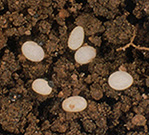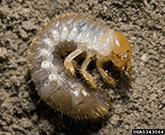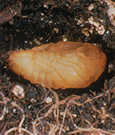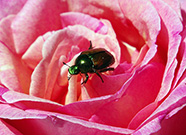home | spring garden | shade garden
Japanese Beetle
Japanese beetles are pests for more than 300 different plants. They were first introduced to North America from Japan in 1916. Female Japanese beetles burrow a few inches into the soil to lay one to five eggs. Females then dig out of the soil and return to feeding and mating. This cycle continues until the female lays up to 60 eggs, usually around mid-August. Eggs take a week or two to hatch. Larvae feed on plant roots and organic matter. When turfgrass has severe root damage, it will have brown patches and can be peeled up like carpet. Larvae burrow deep in the soil to overwinter and go through several stages of molting before they are ready to pupate in the spring. Adults then emerge during late June through July. They release pheromones to attract other Japanese beetles to the same area. Adults are oval shaped metallic green beetles. They have wings and are able to fly, but prove to be poor fliers. With their chewing mouthparts, Japanese beetles eat plant tissue between veins. This can cause massive damage to plants and leave behind what looks like a "skeleton."
 |
 |
 |
 |
 |
